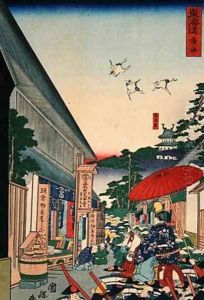Utagawa (Toyokuni III) Kunisada Paintings
Utagawa Kunisada, also known as Utagawa Toyokuni III, was a prolific and influential master of ukiyo-e, the popular woodblock print genre of Edo-period Japan. Born in 1786 in Edo (present-day Tokyo), Kunisada was the pupil of Utagawa Toyokuni I, from whom he inherited the name Toyokuni after his master's death, despite some controversy among his peers and predecessors.
Kunisada's career spanned over five decades, during which he designed tens of thousands of prints, encompassing a wide range of subjects, including kabuki actors, beautiful women (bijin-ga), sumo wrestlers, scenes from literature, and landscapes. His work was characterized by its vivid colors, attention to detail, and a flair for capturing the dynamic energy of kabuki theater. Kunisada's prints were incredibly popular in his time, often outselling those of his contemporaries, such as Hokusai and Hiroshige.
Kunisada's impact on the world of ukiyo-e and Japanese art was significant, as he contributed to the evolution of printmaking techniques and styles. His work often featured luxurious embellishments such as embossing and the use of mica and metallic pigments, reflecting the opulent tastes of the late Edo period. Despite his commercial success, Kunisada's work was not immediately appreciated by later generations, who sometimes viewed it as overly stylized and lacking the subtlety of his predecessors. However, modern scholarship and art collectors have come to recognize the importance of his contributions to the ukiyo-e tradition.
Kunisada continued to work until his death in 1865, leaving behind an immense oeuvre that provides a rich visual record of the cultural life of Edo-period Japan. His legacy is preserved through the many prints that survive in museum collections and as prized items for collectors around the world.




